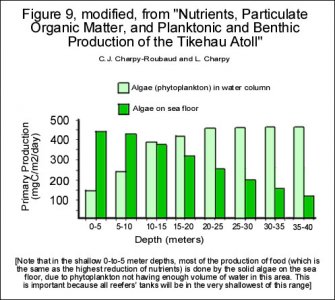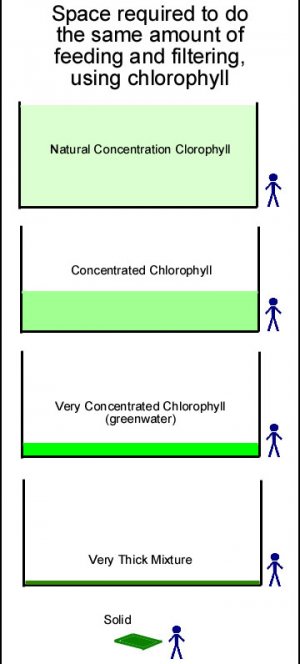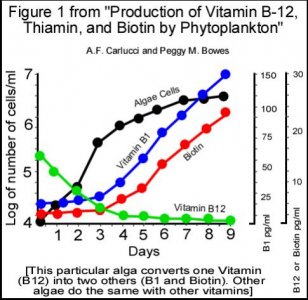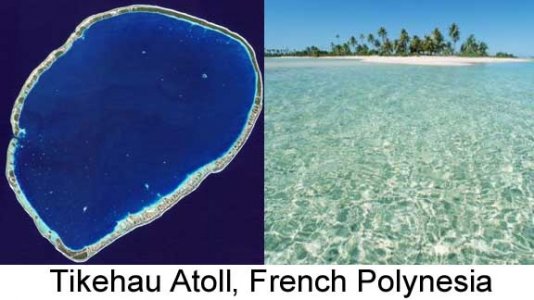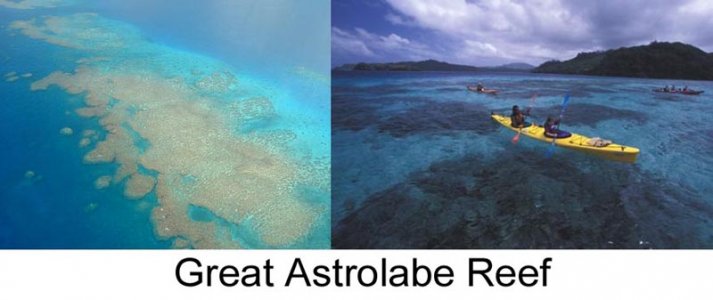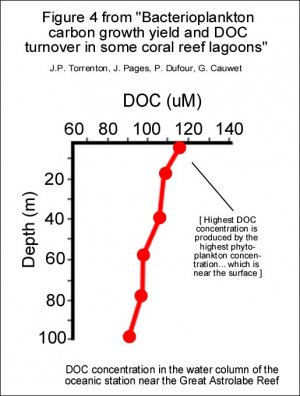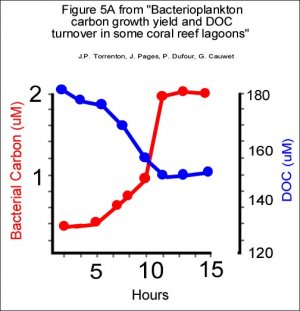"It has long been known that algae produces vitamins and amino acids. Algae, after all, is the main primary producer of food in oceans and lakes, and actually is the most efficient primary producer of food, per unit biomass, on the earth:"
" 'Another significant difference between the land and the oceans lies in their standing stocks [of chlorophyll] - while accounting for almost half of total production, oceanic autotrophs only account for about 0.2% of the total biomass.'
http://en.wikipedia.org/wiki/Primary_production "
"This is because algae grows so quickly. The algae cells multiply so fast that they reach their saturation point (of self-shading) within just a few days. This is compared to things like trees which take decades before they "maximize" their growth." Matter of fact, algae growth is measured in "doublings per day", whereas trees, bushes and grass are measured in "inch or cm per year".
"But on reefs, because the water is so shallow compared to the open ocean, most of the primary production of food is done by sea-floor (benthic) algae (see attached graph) instead of phytoplankton. This is a very fortunate situation for aquarists, because it means you have the option of using the same production of food for your corals."
"So the focus of this writing is vitamins. Corals need vitamins just like you do, and in the ocean, the vitamins are produced by algae (phytoplankton in the open ocean; sea-floor algae on the reefs). Vitamins are also contained in the food you feed your fish, so the fish waste (especially if it goes through a powerhead and gets blended up) goes to feeding corals too. But the vitamins in fish waste are in a particulate form (detritus), whereas algae produces vitamins in a dissolved form (DOC). Both forms, of course, are available to corals on natural reefs, so the idea is to be able to make both forms available to the corals in your tank."
"The following study from 1970 helps clarify this. And while aquarists can have a multitude of varieties of algae working at the same time (thus having many different total vitamins), this study breaks down the vitamin production to individual alga species:"
"Production of Vitamin B-12, Thiamin, and Biotin by Phytoplankton. Journal of Phycology, Dec 1970"
"In the sea, [algae] may contribute a major portion of the amount of dissolved vitamins. In a recent study of the coastal plankton of La Jolla, California, concentrations of dissolved Vitamin B12, Thiamine (Vitamin B1), and Biotin were often highest when phytoplankton standing stock was high. The vitamin requirements of most of the phytoplankters were not known, since only a few have been cultured successfully in the laboratory [in 1970]. But if many of the phytoplankters required vitamins [themselves], it would be reasonable to assume that the dissolved vitamin concentrations of the waters would be low when the standing stock [of algae] was high. But the concentrations of vitamins [in the water], instead, indicated that they were being produced at a rate much more rapid then they were being utilized."
"[In the tests], some ecologically important phytoplankton released vitamins [...] during growth. [Two types of phytoplankton that were tested] produced both Thiamine (Vitamin B1) and Biotin when growing [in water that was supplied with] either 12 or 2 nanograms of Vitamin B-12 per liter. [Another phytoplankton] produced Thiamine [when growing in water supplied with] 12 nanograms of Vitamin B-12 per liter, and [another alga] produced Vitamin B12 and Biotin [when growing in water supplied with] 120 nanograms Thiamine per liter, but only Biotin [when supplied with] 10 nanograms Thiamine per liter. The amount of vitamins produced by an alga, and rate at which it was produced, varied with the phytoplankton, the concentration of the required vitamin [in the water], and the [growing] time. Vitamins produced during early and exponential growth were due to excretions [from the algae], and those produced at stationary growth resulted from excretion and release due to cell [breakage]."
"Table 2. Production of Thiamine and Biotin by [Alga #1], in water with 12 and 2 nanograms of Vitamin B12/liter [simplified]:
12 nanograms of Vitamin B12 in water:
----------------------------------
Stage of Growth.........Molecules/u3/day
.............................Thiamine.........Biotin
0-2 Days....................1080.............76
2-6 Days.....................236..............33
6-9 Days.....................106..............21
2 nanograms of Vitamin B12 in water:
----------------------------------
Stage of Growth.........Molecules/u3/day
.............................Thiamine.........Biotin
0-1 Days....................1100............220
1-3 Days.....................140.............110
3-6 Days.....................620..............30
"Table 5. Production of Vitamin B12 and Biotin by [Alga #2] in water with 120 and 10 nanograms of Thiamine/liter [simplified]:
120 nanograms of Thiamine in water:
-----------------------------------
Stage of growth........Molecules/u3/day
............................Vitamin B12...Biotin
0-2 Days.....................510..........3100
2-5 Days.......................52...........470
5-8 Days........................9............160
10 nanograms of Thiamine in water:
-----------------------------------
Stage of growth.........Molecules/u3/day
............................Vitamin B12...Biotin
0-1 Days........................0.........14000
1-3 Days........................0.........27000
3-6 Days........................0.........49000
"The production of dissolved vitamins into the [water] by phytoplankton may be attributed to excretion, and to release upon death and subsequent [opening] of the cells. In the present study, vitamins produced during early and exponential growth were excreted into the [water]. (The cells looked intact and well-pigmented under the microscope, and were apparently healthy)."
"All the [algae] used in these studies were [sterile] cultures. Therefore, the activities of bacteria in influencing the reported results were eliminated."
"As mentioned previously, it had been observed during the study of coastal plankton that in many cases where the biomass of phytoplankton was high, the concentrations of dissolved vitamins were also high. The results of the present study show that certain [algae], some of which predominate in many blooms, may contribute a significant amount of dissolved vitamins in the waters. The vitamins would be produced by healthy cells, and also released into the water upon death and cell [rupture]. This is also supported by observation of a "red tide" bloom of Newport Beach, California in 1967; [...] the bloom was dissipating, and concentrations of dissolved vitamins were relatively high. It is probably that the activities of phytoplankters (as well as bacteria and other heterotrophic organisms) are important in supplying vitamins to the sea."
"Acknowledgement: This work was supported in part by the Marine Life Research program, Scripps Institution of Oceanography's component of the California Cooperative Oceanic Fisheries Investigation, a project sponsored by the State of California, and in part by the U.S. Atomic Energy Commission."
" 'Another significant difference between the land and the oceans lies in their standing stocks [of chlorophyll] - while accounting for almost half of total production, oceanic autotrophs only account for about 0.2% of the total biomass.'
http://en.wikipedia.org/wiki/Primary_production "
"This is because algae grows so quickly. The algae cells multiply so fast that they reach their saturation point (of self-shading) within just a few days. This is compared to things like trees which take decades before they "maximize" their growth." Matter of fact, algae growth is measured in "doublings per day", whereas trees, bushes and grass are measured in "inch or cm per year".
"But on reefs, because the water is so shallow compared to the open ocean, most of the primary production of food is done by sea-floor (benthic) algae (see attached graph) instead of phytoplankton. This is a very fortunate situation for aquarists, because it means you have the option of using the same production of food for your corals."
"So the focus of this writing is vitamins. Corals need vitamins just like you do, and in the ocean, the vitamins are produced by algae (phytoplankton in the open ocean; sea-floor algae on the reefs). Vitamins are also contained in the food you feed your fish, so the fish waste (especially if it goes through a powerhead and gets blended up) goes to feeding corals too. But the vitamins in fish waste are in a particulate form (detritus), whereas algae produces vitamins in a dissolved form (DOC). Both forms, of course, are available to corals on natural reefs, so the idea is to be able to make both forms available to the corals in your tank."
"The following study from 1970 helps clarify this. And while aquarists can have a multitude of varieties of algae working at the same time (thus having many different total vitamins), this study breaks down the vitamin production to individual alga species:"
"Production of Vitamin B-12, Thiamin, and Biotin by Phytoplankton. Journal of Phycology, Dec 1970"
"In the sea, [algae] may contribute a major portion of the amount of dissolved vitamins. In a recent study of the coastal plankton of La Jolla, California, concentrations of dissolved Vitamin B12, Thiamine (Vitamin B1), and Biotin were often highest when phytoplankton standing stock was high. The vitamin requirements of most of the phytoplankters were not known, since only a few have been cultured successfully in the laboratory [in 1970]. But if many of the phytoplankters required vitamins [themselves], it would be reasonable to assume that the dissolved vitamin concentrations of the waters would be low when the standing stock [of algae] was high. But the concentrations of vitamins [in the water], instead, indicated that they were being produced at a rate much more rapid then they were being utilized."
"[In the tests], some ecologically important phytoplankton released vitamins [...] during growth. [Two types of phytoplankton that were tested] produced both Thiamine (Vitamin B1) and Biotin when growing [in water that was supplied with] either 12 or 2 nanograms of Vitamin B-12 per liter. [Another phytoplankton] produced Thiamine [when growing in water supplied with] 12 nanograms of Vitamin B-12 per liter, and [another alga] produced Vitamin B12 and Biotin [when growing in water supplied with] 120 nanograms Thiamine per liter, but only Biotin [when supplied with] 10 nanograms Thiamine per liter. The amount of vitamins produced by an alga, and rate at which it was produced, varied with the phytoplankton, the concentration of the required vitamin [in the water], and the [growing] time. Vitamins produced during early and exponential growth were due to excretions [from the algae], and those produced at stationary growth resulted from excretion and release due to cell [breakage]."
"Table 2. Production of Thiamine and Biotin by [Alga #1], in water with 12 and 2 nanograms of Vitamin B12/liter [simplified]:
12 nanograms of Vitamin B12 in water:
----------------------------------
Stage of Growth.........Molecules/u3/day
.............................Thiamine.........Biotin
0-2 Days....................1080.............76
2-6 Days.....................236..............33
6-9 Days.....................106..............21
2 nanograms of Vitamin B12 in water:
----------------------------------
Stage of Growth.........Molecules/u3/day
.............................Thiamine.........Biotin
0-1 Days....................1100............220
1-3 Days.....................140.............110
3-6 Days.....................620..............30
"Table 5. Production of Vitamin B12 and Biotin by [Alga #2] in water with 120 and 10 nanograms of Thiamine/liter [simplified]:
120 nanograms of Thiamine in water:
-----------------------------------
Stage of growth........Molecules/u3/day
............................Vitamin B12...Biotin
0-2 Days.....................510..........3100
2-5 Days.......................52...........470
5-8 Days........................9............160
10 nanograms of Thiamine in water:
-----------------------------------
Stage of growth.........Molecules/u3/day
............................Vitamin B12...Biotin
0-1 Days........................0.........14000
1-3 Days........................0.........27000
3-6 Days........................0.........49000
"The production of dissolved vitamins into the [water] by phytoplankton may be attributed to excretion, and to release upon death and subsequent [opening] of the cells. In the present study, vitamins produced during early and exponential growth were excreted into the [water]. (The cells looked intact and well-pigmented under the microscope, and were apparently healthy)."
"All the [algae] used in these studies were [sterile] cultures. Therefore, the activities of bacteria in influencing the reported results were eliminated."
"As mentioned previously, it had been observed during the study of coastal plankton that in many cases where the biomass of phytoplankton was high, the concentrations of dissolved vitamins were also high. The results of the present study show that certain [algae], some of which predominate in many blooms, may contribute a significant amount of dissolved vitamins in the waters. The vitamins would be produced by healthy cells, and also released into the water upon death and cell [rupture]. This is also supported by observation of a "red tide" bloom of Newport Beach, California in 1967; [...] the bloom was dissipating, and concentrations of dissolved vitamins were relatively high. It is probably that the activities of phytoplankters (as well as bacteria and other heterotrophic organisms) are important in supplying vitamins to the sea."
"Acknowledgement: This work was supported in part by the Marine Life Research program, Scripps Institution of Oceanography's component of the California Cooperative Oceanic Fisheries Investigation, a project sponsored by the State of California, and in part by the U.S. Atomic Energy Commission."
[size=-2]link[/size]

